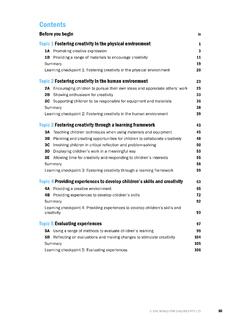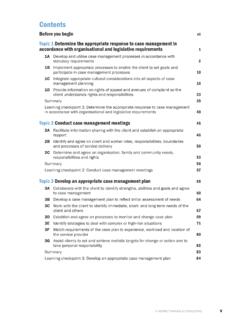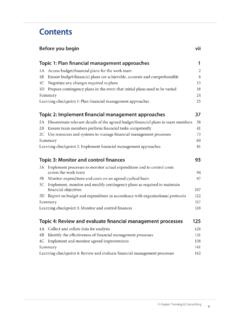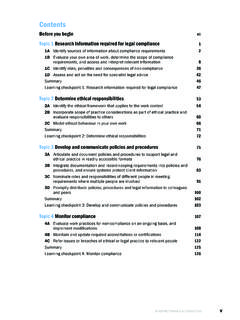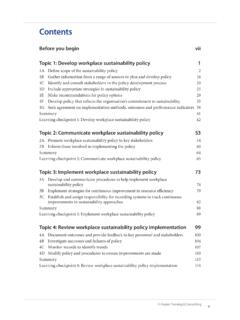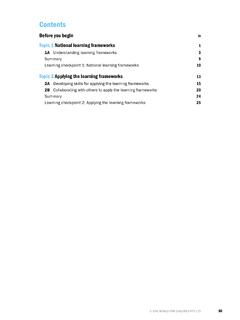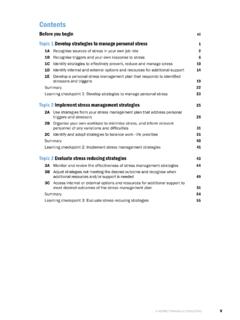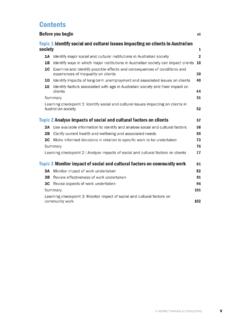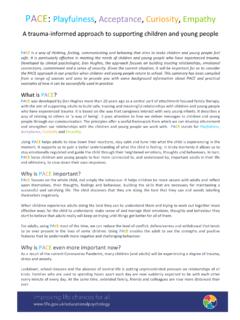Transcription of CHCECE006 Support behaviour of children and young people ...
1 Contents Before you begin iv Topic 1 Contributing to a safe and supportive environment 1. 1A Using appropriate practices 3. 1B Recognising individual issues 13. 1C Identifying environmental factors 20. Summary 23. Learning checkpoint 1: Contributing to a safe and supportive environment 24. Topic 2 Using positive Support techniques 27. 2A Establishing expectations 29. 2B Providing instructions 34. 2C Acknowledging responsible behaviour 36. 2D Guiding and redirecting behaviour 41. Summary 46. Learning checkpoint 2: Using positive Support techniques 47. Topic 3 Collecting data to develop strategies 51. 3A Observing and collecting data about behaviour 53. Summary 59. Learning checkpoint 3: Collecting data to develop strategies 60. Topic 4 Implementing strategies to Support children 61. 4A Implementing Support strategies 63. 4B Identifying areas of concern 71. 4C Contributing to behaviour Support plans 75. Summary 79. Learning checkpoint 4: Implementing strategies to Support children 80.
2 Topic 5 Monitoring and reviewing strategies 83. 5A Monitoring new strategies and adapting levels of Support 85. 5B Providing feedback 92. Summary 95. Learning checkpoint 5: Monitoring and reviewing strategies 96. iii Topic 1 Contributing to a safe and supportive environment Out-of-character behaviour Out-of-character behaviour is usually short term;. it subsides once the situation is resolved. There are many situations that occur in a child 's daily life that can cause this type of behaviour . For example, the child might be: XX unwell XX tired XX stressed XX afraid XX frustrated XX angry. Disruptive behaviour Disruptive behaviour is when a child is uncooperative and prevents themselves and/. or others from focusing on what they are doing. A disruptive child might also grab the educator's attention, distracting them from the other children and the task at hand. It is normal for children to exhibit disruptive behaviour as they struggle to learn self- control. Not all disruptive behaviour is of concern, but it should be addressed as part of your regular Support to help children develop their social and emotional skills.
3 Disruptive behaviour could take the form of: XX not following instructions XX talking loudly or making inappropriate noises XX leaving the area or wandering around XX throwing objects XX crying; tantrums XX isolation from peers. behaviours of concern behaviours of concern, previously called challenging behaviour ', are when a child does something that hurts themselves and/or other people . These types of behaviours can prevent children from participating in activities. They can harm others and are stressful and upsetting for all involved. Note the following: XX It is the behaviour that is the problem, not the person. XX These behaviours are not uncommon. Many children behave this way at times. XX behaviours are only considered of concern' when they cause a problem to the child or those around them. 9. CHCECE006 Support behaviour OF children AND young people . Emotional Many behaviours of concern are linked with mental health in and social some way. Emotional and social problems can be the cause or the problems outcome of a mental health condition.
4 The feelings that children express must be taken seriously. Like all of us, children have good and bad days; sometimes they will need extra Support to deal with problems and enjoy their learning and play. Mental health issues can affect a child 's capacity to: XX form friendships XX resolve conflict XX make decisions XX learn about other people XX develop life skills XX separate from parents and/or educators XX play freely XX develop confidence XX deal with anger XX accept behaviour guidance. To read more about mental health issues in childhood, go to the KidsMatter website at: Trauma The word trauma' describes a deeply distressing or disturbing event and the emotional shock that follows it. Trauma can seriously affect a child 's mental health and behaviour . The severity of trauma is defined by the effect it has on an individual. Trauma may relate to various events, such as grief, loss, war or being held in custody. A child who has experienced trauma may show behaviours such as: XX difficulty sleeping or disrupted sleep patterns XX loss of appetite or refusal to eat XX regression in development XX anxious responses to separations or unfamiliar events, situations or people XX social withdrawal or restricted play XX re-enacting an event in play, sometimes repeatedly XX aggressive behaviour with others XX fantasising about an event XX expressing intense emotions inappropriately XX flashbacks XX hyperarousal the child is continually alert and looking for danger or threats.
5 18 ONE WORLD FOR children PTY LTD. CHCECE006 Support behaviour OF children AND young people . Seeking advice If you identify behaviour of concern, or feel that you need advice in guiding behaviour , there are plenty of people that can help you. Making decisions about a behavioural situation is not your responsibility alone. You can seek the Support of your supervisor, colleagues and service management, as well as professional organisations. Consult with these people , particularly if the behavioural issue is concerning. If you need to seek advice from outside your service, it is recommended that you contact the Inclusion Support Programme (ISP). This program is available to all government-approved suppliers, including long day care, occasional care, family day care, in-home care, school-age care and vacation care. Remember that before you involve an outside body you must gain parental permission. You should make it clear that you are not only seeking Support or assessment for the child .
6 Your main objective is to obtain Support and advice so that you can meet the child 's needs. Consulting other sources Consultation is another way to gather information about a child . Good sources include parents, educators, specialists that have been involved with the child , and even other children at the service. If you decide to use this strategy, make sure you have parental permission before you start. Who What they can tell you about How to gather this information Parents or XX Home life, including values, cultural XX Discussions guardians practices, expectations and beliefs XX Meetings XX How the child behaves in various XX Surveys environments XX Forms XX Who the child responds to XX Triggers XX What strategies they use XX What strategies work and don't work XX What strategies they would not like you to use Other XX Their observations XX Observation educators XX Their experiences with the family and child records XX Out-of-character behaviour , expected XX Portfolios behaviour and behaviour of concern XX Notes from past XX Triggers information- gathering XX What strategies they have used.
7 Successfully or unsuccessfully XX behaviour plans XX Their specialist training or experience XX Discussions Specialists XX Diagnosis XX Discussions XX Triggers XX Assessments XX Key features XX Reports XX Links to other developmental areas XX Meetings XX Situations to avoid 32 ONE WORLD FOR children PTY LTD. Topic 2 Using positive Support techniques Developmental considerations If you want your instructions to be understood, you must also keep in mind the children 's age and stage of development. Try to consider the guidelines in the following table. Age/stage Guidelines children Give simple one-step instructions. For example: under three XX Put your bag away.'. XX Wash your hands.'. XX Take your socks off.'. Preschool Give simple two-step instructions. For example: children XX Put your bag away and then come to the mat.'. XX Wash your hands and then sit at the table.'. School-age Give multi-step instructions. For example: children XX Clear up the bench, then set the table for lunch.
8 After that, go outside and see what Joe has for us from the garden.'. XX First set out your design, then glue it. Once that is done, paint the surface and let it dry.'. Practice task 5. 1. What is an instruction you might give to children during a mealtime? Ensure your instructions are clear, easy to follow and positive. Include one instruction for each of the following age groups: a. Two years old b. Five years old c. 12 years old 2. If the room is noisy, how would you change the way you communicate these instructions? 35. Topic 2 Using positive Support techniques Encouragement Encouragement shows children that you value them and their efforts, and is a great way to acknowledge responsible behaviour . Encouragement: XX motivates the child to do things for intrinsic reasons XX focuses on the child 's efforts in or process of doing something, not the results XX helps the child feel good about what they have done, which develops their self-esteem. You should encourage each child 's efforts, whether they succeed or fail.
9 Make sure you are honest and consistent, and that what you say is sensitive to each child 's needs and matches their level of understanding. v 0042. Watch this video about encouraging and engaging with children . Using encouragement to respond to a child Example Kiara, two years old, is trying to help pack up by carrying a big basket of soft toys. Every few steps a toy falls out of the basket. She stops, puts the basket down, puts the toy back in the basket and sets off again. She does this four times. The fifth time a toy falls out, she stops, looks at it, then carries the basket to the shelf where it belongs. She then goes back to the toy on the floor, picks it up and takes it to the basket. The educators says to Kiara, Kiara, I can see you are trying very hard. Thank you for your help.'. This type of encouragement acknowledges Kiara's efforts, but does not require her to follow a particular process as long as the job gets done. Positive language If you want a child to demonstrate positive behaviour , use positive language.
10 Consider the following two examples. One uses positive language and one does not. Situation What the educator says An educator sees a child running in Sean, no running in the room. You from outside. know that's not allowed!'. An educator sees a child running in the Hello, Daisy! You seem in a hurry, hall at the end of the day. remember to walk safely in the hall.'. Positive language shows your belief in the child 's abilities and intentions. You acknowledge that they are capable of doing the right thing, which encourages the child to develop more awareness and self-control. Use your words, tone of voice, facial expressions and body language to communicate calmness and respect. Try not to make judgments. Keep the focus on the positive behaviour you want to see, rather than highlighting any negative or inappropriate behaviour that may be noticeable at the time. 37. Topic 2 Using positive Support techniques 2D Guiding and redirecting behaviour Guiding and redirecting the behaviour of children is an approach you will use countless times each day.
